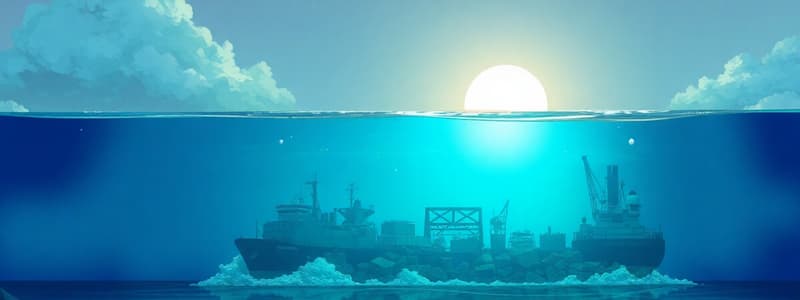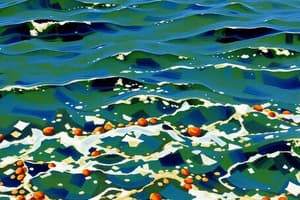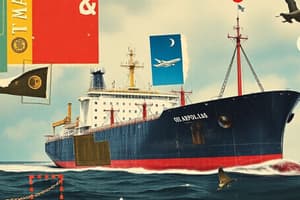Podcast
Questions and Answers
When did MARPOL come into force?
When did MARPOL come into force?
October 2, 1983
What does MARPOL 73/78 stand for?
What does MARPOL 73/78 stand for?
Marine Pollution
Which annex focuses on the prevention of oil pollution?
Which annex focuses on the prevention of oil pollution?
- Annex II
- Annex I (correct)
- Annex IV
- Annex III
What is a key provision of Annex II?
What is a key provision of Annex II?
What is required for sewage pollution prevention according to Annex IV?
What is required for sewage pollution prevention according to Annex IV?
Which annex was added later in 1997?
Which annex was added later in 1997?
MARPOL 73/78 includes regulations for the prevention of plastic discharge into the sea.
MARPOL 73/78 includes regulations for the prevention of plastic discharge into the sea.
What are the penalties for non-compliance with MARPOL regulations?
What are the penalties for non-compliance with MARPOL regulations?
What significant update was made in 2020 for MARPOL?
What significant update was made in 2020 for MARPOL?
Flashcards are hidden until you start studying
Study Notes
MARPOL 73/78
- International Convention for the Prevention of Pollution from Ships
- Adopted in 1973, with the Protocol added in 1978
- Came into force on October 2, 1983
- Aims to prevent marine pollution from ships
Annexes
- Annex I: Regulations for Oil Pollution Prevention
- Focus on preventing pollution from operational discharges and accidents
- Requires oil discharge monitoring equipment, oil record books, and oil pollution prevention certificates
- Includes special areas with stricter discharge standards
- Annex II: Regulations for Noxious Liquid Substances in Bulk
- Focus on controlling pollution from chemicals carried in bulk
- Categorizes substances based on their hazard level
- Requires cargo handling, tank washing, and discharge procedures
- Requires pollution prevention certificates for chemical tankers
- Annex III: Prevention of Pollution by Harmful Substances in Packaged Form
- Focus on preventing pollution by harmful substances carried by sea in packaged form
- Includes proper labeling, documentation, and stowage requirements
- Requires safety measures for handling and transportation
- Annex IV: Prevention of Pollution by Sewage from Ships
- Focus on preventing pollution by sewage from ships
- Includes regulations on sewage discharge into the sea
- Requires sewage treatment plants or holding tanks
- Requires sewage pollution prevention certificates
- Annex V: Prevention of Pollution by Garbage from Ships
- Focus on preventing pollution by garbage from ships
- Includes comprehensive rules on garbage management
- Prohibits plastic discharge into the sea
- Requires garbage record books and management plans
- Annex VI: Prevention of Air Pollution from Ships (added in 1997)
- Focus on preventing air pollution from ships
- Includes limits on sulfur oxide (SOx ) and nitrogen oxide (NOx) emissions
- Regulates ozone-depleting substances
- Includes Emission Control Areas (ECAs) with stricter emission limits
Implementation and Compliance
- Flag State Responsibilities:
- Ensuring compliance with MARPOL provisions on ships registered under their flag
- Port State Control:
- Inspections and enforcement of MARPOL regulations in ports
- Penalties:
- Consequences for non-compliance, including fines and detention
Amendments and Updates
- Continuous Evolution:
- Regular amendments to address emerging environmental concerns
- Recent Updates:
- Addition of new regulations and stricter emission controls, such as the 2020 sulfur cap
Global Impact
- Environmental Benefits:
- Significant reduction in marine pollution since its implementation
- Challenges:
- Enforcement and compliance in developing countries
- Addressing illegal discharges and pollution
Studying That Suits You
Use AI to generate personalized quizzes and flashcards to suit your learning preferences.




